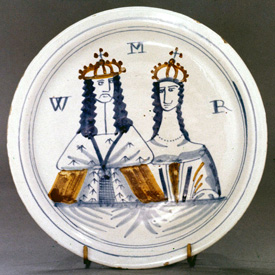The "Glorious" Revolution of 1688

A delft plate showing King William and Queen Mary.
Often referred to in England and its colonies as the "Glorious" Revolution, the Revolution of 1688 resulted in the abdication of the Catholic James II and the succession of the Protestant William III and Mary II. It also established parliamentary sovereignty within the constitution through the package of laws that became known as the Revolution Settlement of 1689. Although some historians view it as little more than a coup supported by a foreign invasion, others see it as a Whig victory for a properly limited monarchy, stress the critical role Tories played when they failed to rally to James's support, and highlight the compromise nature of the Revolution settlement. Yet the Revolution of 1688 was anything but glorious outside of England. In Scotland and Ireland it was not a bloodless victory for a mixed and balanced constitution, but rather a series of brutal battles over the naked exercise of sovereign authority. Even in the American colonies, particularly Maryland, there was turmoil and bloodshed. Yet, in the end, the Revolution of 1688 established the interpretation of the British constitution that would remain at the core of Anglo-American constitutional thought throughout the eighteenth century.
By any measure, however, the main culprit of the Revolution of 1688 was James II himself. Almost immediately upon succeeding his brother Charles II in 1685, James began to squander the popularity that marked his accession. Although he had pledged to uphold the Church of England and the rights of Englishmen imbedded in the ancient constitution, James II began to use what he called the "dispensing power" of his royal prerogative to go around Parliament and suspend laws that penalized Catholics and nonconformists. He also embarked on an extraordinary campaign to restructure England's body politic from the local to the national level, so as to ensure the adoption of policies to establish Catholic toleration. In April 1688, most clergymen refused to read his Declaration of Indulgence from the pulpit, and the Archbishop of Canterbury and six bishops petitioned the crown that such a declaration was illegal. Prosecuted by James for seditious libel, they were acquitted by a jury in June.
Just several weeks before, however, on June 10, came the most serious blow to his position: the birth of a Catholic son, James Francis Edward, who would take precedence over James's Protestant daughters (from a previous marriage) in the line of royal succession. Shortly thereafter a group of seven politicians troubled by the prospect of a Catholic heir, and worried by James' arbitrary government, invited William of Orange, James's nephew and husband of Mary, James's daughter, to England to rescue the Protestant cause and English constitution. William's landing on November 5, 1688, with more than 14,000 veteran Dutch troops, sparked a rash of personal and military desertions from James. His daughter Anne fled to William, along with some of his most trusted army officers. James's forces, however, still easily outnumbered William's but they would never see combat. James, who had already backtracked on many of his vexatious policies, chose instead to flee England in December 1688, leaving the crown truly vacant and William in control of London.
A Convention Parliament met in January 1689 and determined that James had abdicated his throne by abusing the constitution and taking flight from England. It declared Mary and William (who were first and third in the Protestant line of succession in their own right) joint sovereigns in February. On April 11, 1689, they were crowned after reading aloud the Declaration of Rights, later passed into law as the Bill of Rights.
For Scotland and Ireland, the Revolution of 1688 was a more complicated matter. In Scotland, the Presbyterians were able to purge anything smacking of episcopacy from its church, while further limiting the authority of the crown. James' supporters, known as Jacobites, were not easily or entirely suppressed, as adherence to the Stuarts remained strong in the Highlands and Northeast for much of the eighteenth century. In Ireland, the Revolution became a bloody affair when the Catholic majority warmly welcomed James and his mostly French army to Dublin in March 1689. A Catholic parliament (later known as the "Patriot Parliament") restored political and economic rights to Catholics and recognized James as King of Ireland, but William's army destroyed James's forces in the Battle of the Boyne on July 1, 1690, after which James, explaining that "I do now resolve to shift for myself," fled back to France. Subsequent Protestant Irish parliaments passed legislation even more repressive against Catholics than before the Revolution.












